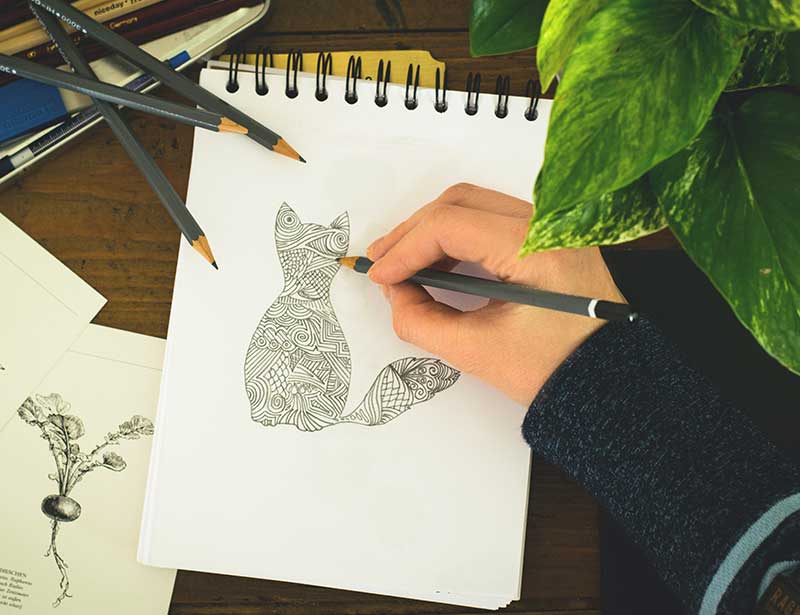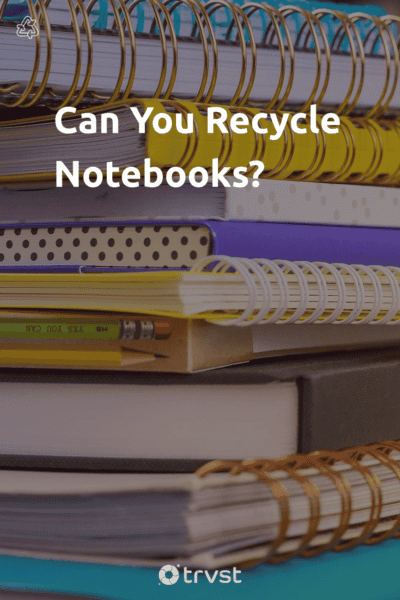Can You Recycle Notebooks?
As society becomes more environmentally conscious, we are all looking for ways to reduce our environmental impact. Besides making big changes to reduce your carbon footprint, small changes also make a difference. One of the changes you can make is reusing and recycling old items you own. Notebooks are a staple in almost every space we find ourselves in. We use them within the home, in offices, and also in schools. Since notebooks have short life spans, the question of “can you recycle notebooks?” arises.
Thankfully, we can recycle most notebooks as a final option. If you have old notebooks sitting around, it’s time to declutter and find new creative ways to reuse them. If you’re out of reuse options, this article will provide helpful information on how to recycle notebooks. By recycling, you reduce the waste you produce and also prevent adding to landfill sites.
Related: Once finished with your old notebooks and looking for new ones, have a browse of our picks of the best eco-friendly notebooks and eco-friendly diaries for sustainable replacements - some you can even reuse again and again.
How Do You Dispose of Old Notebooks?

School students, office workers, entrepreneurs, and professionals use notebooks for various reasons. As a result, many of us go through many notebooks in our lifetime. To prevent contributing to landfill waste, we can put these papers and books to good use.
Notebooks come in different sizes, shapes, and colors. They also come with various components, some of which are not the best for the environment.
Before throwing old notebooks in the trash can, consider giving them a new life. Below are some ways you can dispose of your old notebooks. From spiral notebooks to loose-leaf and everything in between, you can find various uses for them.
Related: Can you recycle old books?
Reuse and Upcycle
This method isn’t necessarily disposing of old items. Instead, it allows you to find creative new ways to reuse the materials of your notebook. You can put all the components to use in many ways.
- If your notebook still has empty pages, you can create a new notebook out of it. Remove all the paper from the spiral binding or whatever binding components are in place. Then, make holes in the blank paper and use yarns to hold them together. You can also create a cardboard cover, giving you a fresh new book.
- You can create craft projects with the papers of old notebooks. This can range from origami projects to scrapbook-style designs.
- Avoid throwing your notebook out by filling up all the pages. Many times, people throw notebooks in the trash even though there are still empty pages. A simple eco-friendly act is to use up all the pages.
- Apart from paper, you can also reuse and upcycle notebook components. For instance, if you have a spiral notebook, the notebook’s coil can become a wire for hanging pictures.
Related: Read more on the Importance of the 4rs- Refuse, Reduce, Reuse and Recycle
Donate Your Old Notebooks
Apart from textbooks, did you know you could also donate lightly used notebooks? Many schools and charity programs will be happy to accept gently used notebooks with spare pages to write on. Some may even take ones filled with your jottings for their own craft projects.
Gift Your Notebooks to Younger Ones
For instance, if you have notebooks that you used for coursework, you can give these to your younger ones. In cases where they’re studying the same or similar course, these notebooks will be useful to them. Or inspire them if you have filled your old notebooks with designs and creative drawings.
Recycle Your Notebook
You can recycle most notebooks. You’ll have the option of adding them to the curbside recycling bin or sending them to a recycling center.
Since notebooks have various components, these components will have to be recycled separately. So, before you throw your old notebook away, remember you have many options. You’ll find out more details on how to recycle specific notebooks like spiral notebooks below.
Recycling Notebooks
There are various types of modern notebooks. They come in many designs, shapes, colors, and sizes. You’ll find many of the notebooks you own easily recyclable. However, the procedure for each type will vary. The process will also differ depending on the recycling system in your area. Regardless of these differences, you can either recycle them with your local recycling center or add them to a recycling bin.
Are All Notebooks Recyclable?
If you have many notebooks, notepads, and journals in your home or office, the good news is that you can recycle them. Most notebooks can go through the recycling process, which means you don’t have to throw them all out. However, you need to note that manufacturers create notebooks differently.
With advances in technology and innovation, notebooks are not as plain as they used to be. Today, we have books with brightly colored papers, spiral designs, and various cover types. These intricate designs come with different kinds of materials that can’t go in the same curbside bin. Some notebooks have metal rings, highly pigmented papers, cardboard covers, and so on. Some of them also have plastic covers on them.
Spiral notebooks come with various materials. They might have a plastic cover, paper cover, or hard cover. The spirals also come in different materials, mainly metal or plastic. As a result, each component of the spiral notebook must be separated. However, many recycling centers will generally accept spiral notebooks. They just need a little extra effort to separate the components carefully.
Apart from a spiral-bound notebook, a loose-leaf notebook and a hardcover book are also recyclable. The same process whereby the materials are separated also applies. One area of concern in notebook or paper recycling is highly pigmented paper. If your book has black, dark-colored papers and even bright ones, you may need to throw them out. These pigments can contaminate other papers, thereby rendering other papers useless. As a general rule, avoid adding any highly pigmented paper to the recycling bin.
Not all local recycling programs have advanced recycling systems to cater to every component of your book. However, the good news is that you can always recycle paper, except in some cases when it's dark-colored paper. It’s best to find out from your town or city’s guide to figure out the best way to dispose of this.
The Process of Recycling Notebooks
Recycling notebooks is an eco-friendly practice that helps to reduce the trash in landfills. You can recycle most of the notebooks you own - from old spiral notebooks to notepads. The process is similar regardless of the type of notebook you own. However, there are still slight differences. Rest assured that recycled paper can form new items when you recycle paper. This recycled paper also saves trees and prevents the extraction of raw materials. Here are the general steps to recycle your notebook.
Remove the Cover
Books have different types of covers. One might come with a plastic cover while another with paper, leather, or a hardboard. Although facilities can recycle some of these parts, you need to separate them from the paper parts. If it’s cardboard paper, most times, it can go in the curbside recycling bin.
A plastic cover will require consideration as to its recyclability. Not all types of plastic can be recycled. For instance, polyvinyl chloride (PVC) can be difficult to recycle. Check with the local recycling authorities for details.
Related: Different types of plastic waste
Take Out Any Binder
To avoid disrupting the procedure, remove any form of binder from the paper parts. A spiral notebook, for instance, usually comes with a metal coil. However, some manufacturers also use plastics.
Remove the Coloured Paper
As mentioned earlier, brightly colored or dark-colored paper may not be suitable to be recycled with white paper. These paper types usually leave color pigments on other papers. This then affects the quality of the recycled paper.
Put the Parts in the Right Places
White or light papers can usually go in your regular paper recycling bin. Cardboard paper can also go in curbside recycling bins along with paper in most cities. If you’re unsure of your city’s guidelines, be sure to ask the local authorities. If your paper is recycled paper and contains soy-based inks, you might also be able to compost it. Metal coils can go with other metal products.
However, you might need to send these metal parts to recycling centers in some cases. Some cities also have advanced recycling systems that allow you to throw the book, still bound together, in the recycling bin. Such places have systems that can easily separate the paper from other parts.
Can You Recycle Spiral Notebooks?

Spiral-bound notebooks are popular. The good news is that you can recycle them in most cities. We can easily identify them with their wire-bound features. Regardless of their designs, they have a common pattern of coils that hold the papers together. This coil could be on the side of the notebook or at the top. It could also be either metal or plastic material.
Due to these various parts, you might think a spiral-bound notebook is difficult to recycle. However, all it requires is separating the different parts before throwing them in the appropriate bins. Follow these simple steps to recycle your spiral-bound notebook properly:
Separate the Cover
Similar to the general procedure, remove the spiral notebook’s cover from the papers. If the cover is plastic, you need to find out what type of plastic it is. Most times, you’ll find this at the back of the notebook. Remember that not all plastics are recyclable. However, if it is, the knowledge of the plastic-type will inform you on which bin to put it in.
Some programs allow you to join it with other papers if it's a cardboard cover. Check with recycling centers near you for unique covers like leather, wood, and vinyl. Since systems are different, you’ll need to check with the local guide.
Remove the Coil
The coil is the main tricky part with spiral notebooks. However, you only need to check whether it is a metal or plastic coil. Most cities will allow you to put the metal coil in metal recycling bins. However, if it’s a plastic coil, you’ll need to check what type of plastic it is and if you can recycle it. To remove the wire or coil, you can follow either of these two methods:
- Use a pair of pliers to clip the wire at the bottom. After straightening the ends with the plier, use your hands to begin to unwind the coil.
- For notebooks with separate coils for each pair of holes, use your hands or a plier to pull out the coil from the holes.
Removes Metals, Paper Clips, Staples, and Other Additional Parts
To avoid contaminating the papers, make sure you remove clips, stickers, staples, and pins. After removal, you can then put them in the correct bins or, better yet, reuse them.
Recycle the Notebook Pages
Once separated from other parts, you can place your papers in the regular recycling can. Remember to separate highly pigmented ones as they can contaminate the white papers.
Conclusion
Now that you’re aware that you can recycle your old notebook, you can take eco-friendly steps to reduce waste.
Living sustainably also involves disposing of small everyday items in a low-impact way. With any notebook you have, ensure you properly check its components to place these parts in appropriate bins. Also, check with local recycling authorities if unsure of where to place each item.
Jen’s a passionate environmentalist and sustainability expert. With a science degree from Babcock University Jen loves applying her research skills to craft editorial that connects with our global changemaker and readership audiences centered around topics including zero waste, sustainability, climate change, and biodiversity.
Elsewhere Jen’s interests include the role that future technology and data have in helping us solve some of the planet’s biggest challenges.

